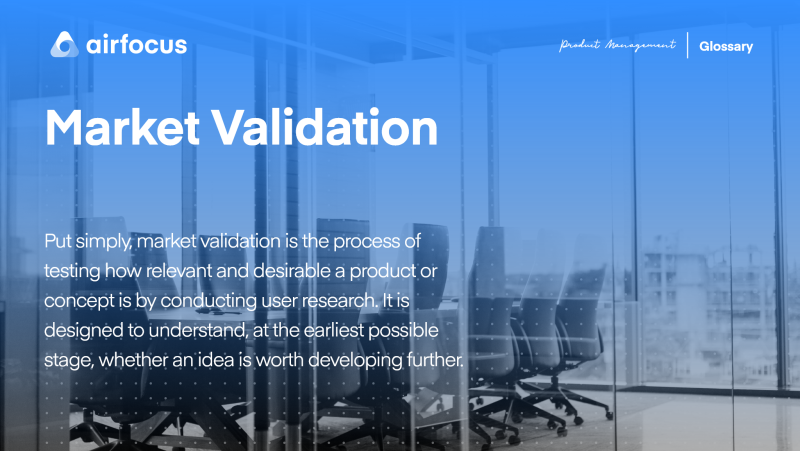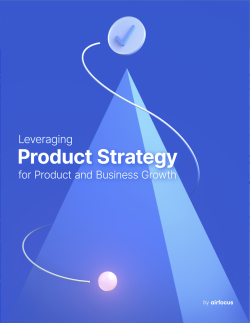Market Validation
What is Market Validation
Definition of Market Validation
Put simply, market validation is the process of testing how relevant and desirable a product or concept is by conducting user research. It is designed to understand, at the earliest possible stage, whether an idea is worth developing further.
Concepts are usually validated via in-person interviews, but sometimes using digital surveys too.
No matter which methodology is pursued, the most important thing is that this process is carried out with genuine potential end users, that questioning is neutral and non-leading, and that it happens at an early stage in the development cycle.
The feedback gathered during market validation will demonstrate whether your product hypotheses are accurate, and/or whether there is an appetite in the market for your solution. The benefits of market validation.
Conducting proper market validation will have a significant impact on product development, namely in the following areas:
1. A deeper understanding of the market
Many businesses will likely have a good understanding of market conditions, but this doesn’t always translate to a good understanding of the products that real users need or want.
Early stage market validation can help to minimize this risk.
It empowers businesses to develop a much deeper understanding of the kinds of features a product should have in order to resonate with the end user, as well as any other important insights that will impact positioning and messaging.
Download now: Get our 5- minute guide on Why Insights Are Essential and How to Source Them
Market validation is also an opportunity to test early ideas openly with your target market to give a user perspective on whether a solution is viable.
Ultimately, market validation is crucial to avoid spending money and time developing the wrong thing.
After all, asking whether an idea would work is much cheaper than realizing it won’t after it has been developed.
2. Securing funding
Whether your product needs internal budget allocation, or your start-up is looking for its next round of funding, the investment will always require proof of product-market fit.
The cheapest and most effective way of doing this is in the early stages of product development through market validation with genuine end users.
The results of your market validation process should clearly demonstrate that the pain point you’re solving is big enough for your target audience to pay for a solution.
How to carry out market validation
1. Define your target market
Market validation is an interview or survey-based research with a specific target market, so it is first important to define who that is.
In defining the target market, it’s important to determine:
Who are they? (Age, gender, life stage, location, socio-economic level, etc.)
Why do I think they will use the product?
What specific problem(s) do you believe your product solves?
How can I contact them?
2. Find and engage your target market
How you find and engage your target market will vary depending on the product or service.
A mass-produced retail product may require several hundred responses from prospective customers, whereas a consultancy service or solution may require just three to four in-depth interviews.
Advertising, leveraging existing networks, and — to a certain extent — cold calls and emails can help you engage your target audience in your market validation process.
You can also work with dedicated research or respondent recruitment service, to outsource the responsibility of finding the right interviewees — these partners may also have more experience and a greater reach.
It’s also worth considering whether you should incentivize participation by offering something in exchange for people’s time.
A word of warning though: it’s often against market research rules and regulations to offer a discount or voucher code for your own business, as a thank you for taking part.
Whilst incentives may be required for some research studies, often people are often willing to share their feedback voluntarily, so don’t let this put you off if your budgets are tight!
3. Build a bias-free, non-leading question set
Conducting market validation is only worth doing if you uncover genuine user needs, beliefs and intentions. Very often though, responses can be hugely impacted by the intent or desires of the person conducting the interview.
It’s therefore essential that you strip all bias out of the process, by ensuring that questions are open-ended, neutral, and pre-planned.
The first few questions should be focused on understanding how and why interviewees do certain things or behave in certain ways, without ever suggesting solutions or changes.
Your aim here is to understand the context of priorities, problems, and concerns.
Once you’ve developed an initial understanding of the interviewee, you can begin introducing the product or solution in a non-leading round of questions.
The most important thing to remember here is that all interviewees should follow the same series of questions so that they can analyze the data consistently.
That’s not to say that should something surprising come up, you ignore what the respondent has said — you can follow unexpected pathways of inquiry, but make sure you always come back to your pre-planned discussion guide.
4. Test your question set
Before launching into a full market validation process, it helps to test out your interview questions with a small group first (a mini market validation in itself!).
These first few interviews should test not just your interview method, but whether your assumptions about the interview were correct.
Based on these first interviews, you may decide to tweak, remove or add some questions — perhaps the flow of questioning doesn’t feel so natural now you say it out loud, or an interviewee's actions encourage you to ask a more pertinent question in response.
You may also consider adjusting the length of the interview as well as where they are held.
5. Conduct the interviews
When it comes to conducting the interviews, there are certain cues you can use to put respondents at ease and introduce them to the interview process.
For one, think about who you are talking to. If you’re looking to validate a social media product with teenagers… maybe don’t turn up wearing your sharpest suit!
Next, you should build in some time — however brief — to get to know the interviewee before you dive in. At the very least, introduce who you are and ask them a little about themselves.
Many researchers also like to use a ‘breaking the ice’ creative question, to get the ball rolling.
Crucially, you don’t want to let off exactly how close you are to the product being tested.
If you make it clear that you play a key role in the product development, the interviewee may feel hesitant to feedback on any issues or concerns they have about the design.
Lastly: a small logistics point. It’s recommended that the bulk of the interviews are conducted by a single researcher, e.g. the product manager.
Not only is the PM likely to have the deepest knowledge about the target user, market, and other important details, but it’s much easier to spot insights when the interviews haven’t been spread across the whole team.
If you’ve got too many interviews for the PM to handle alone, then one or maybe two others can step in to take some on.
6. Analyze the data
Once you’ve carried out your market validation interviews (or surveys), the next step will be to make sense of the data.
How responses and data provide validation is open to interpretation. It can be tempting, as the owner of an idea, concept, or product, to see validation even if it’s not actually the case.
It is therefore critical that the analysis is as objective and as data-driven as possible, and aims to answer specific questions about the product, such as:
Did the product solve the original problem?
Which features of the product work/do not work?
Is the information clear and easy to understand?
Did they understand the functionality?
Were there any legal, operational, or price issues?
To remove bias, try to pull as much raw data from the research to back up your findings.
For example, if a number of users complained that the navigation wasn’t clear: how many users said this? What percentage of the sample does that represent? Can you use (anonymous) quotes to bring this insight to life?
Conversely, if the feedback has been overwhelmingly positive, then user verbatim is a great way to celebrate this when sharing with stakeholders.
Collecting and presenting quote after quote of market validation not only shows there’s been no bias involved but gives you a very clear green light to proceed.

General FAQ

Glossary categories
Create effective product strategy

Experience the new way of doing product management








